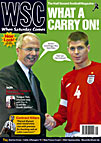 What was your club's never-to-be-repeated greatest moment? For Limerick fan Emlyn Begley it was almost beating Real Madrid, as he recalls in the first of a series
What was your club's never-to-be-repeated greatest moment? For Limerick fan Emlyn Begley it was almost beating Real Madrid, as he recalls in the first of a series
There was a time when Real Madrid didn’t spend £40 million on a galáctico every summer. There was a time when Limerick FC were not bottom of the Irish First Division. There was a time when these two sides met.
The year was 1980. Limerick United, as they were then called, had just clinched their second Irish League championship. Real may not have spent enough each summer to build several hospitals, but they were still one of the most feared teams in Europe. They had several big-name Spain internationals, plus West Germany’s Uli Stielike and Laurie Cunningham. Limerick, on the other hand, only had five players who had ever played in European competition. The Spaniards’ squad had an accumulative value of about £4m, 50 times more than Limerick’s playing staff.
Limerick fans, and the public in general, had been looking forward to seeing these footballing giants coming to town, for the European Cup tie. Except they weren’t coming to town. Limerick’s chairman, Michael Webb, decided to move the tie 125 miles away to Dublin’s Lansdowne Road. UEFA were clamping down on pitch invasions and the risk of keeping the game at their Markets Field stadium, or even moving to the bigger Thomond Park, was deemed too great.
The move to the capital city was also expected to bring in some much needed income. However, it backfired as the Dublin public stayed away. Real Madrid did not have the pull of the big English teams and Limerick did not have a large fan base in Dublin. The move was expected to attract over 30,000, but only 6,500 turned up – said to be the lowest attendance ever to watch a Real Madrid competitive match. Those who didn’t turn up missed what was almost one of the greatest moments in Irish football history.
Real Madrid had just beaten Bilbao 7-1 and were expecting an easy night, but were given the fright of their lives by a determined Limerick team, led by the Irish national manager, Eoin Hand. Limerick were denied a shock lead when 35-year-old Johnny Matthews had a headed goal controversially disallowed for offside. But six minutes after half-time, a free-kick from out wide reached Des Kennedy. He calmly headed the ball over defender Gallego before beating goalkeeper Miguel Angel to send Lansdowne Road into delirium. Kennedy celebrated his goal by running to the ironically desolate south terrace.
With 20 minutes to go, Limerick were looking at the greatest result in their 42-year history. However fate, in the form of Mr Amundsen, the referee, had other plans. With substitute Pineda heading nowhere, Limerick’s goalkeeper, Kevin Fitzpatrick dived at his feet to collect the ball. Pineda sent himself flying to the ground and the Danish referee pointed to the spot. Juanito ignored the understandably incensed home crowd to put away the equaliser.
Limerick’s semi-professional legs were beginning to tire, but they were still giving their all. However, with only six minutes to go, Fitzpatrick could only deflect Juanito’s shot on to Pineda, who scored to deny Limerick their greatest ever draw.
Limerick lost the second leg 5-1 in front of 60,000, plus a hundred or so travelling supporters, with Kennedy scoring their goal again. Real went on to be runners-up, only conceding two more goals in the tournament, including Alan Kennedy’s winner for Liverpool in the final. Limerick reached the UEFA Cup the following season.
Fast forward 24 years. Limerick, playing at the second level of the League of Ireland, reached the promotion play-offs, but lost in the semi-finals to Derry City. Most of the talented players left the club, leaving manager Mike Kerley with only the bare bones of the successful squad, including the Ireland Under-19 captain, right-back Steve O’Mahoney. This season Limerick find themselves seven points adrift at the bottom of the table, halfway through the season. They are out of both cups and have been forced by various injury crises to play both their goalkeepers outfield. For one match they weren’t able to name any substitutes. They play at a ground owned by a non-League club, with average attendances of around 200. The financial situation is extremely poor with the players even having to buy their own lunches while on team duty. Non-League teams in Limerick are among the best in Ireland, but controversial local rules mean that if Limerick FC use these players, they cannot play for their original clubs for 18 months. Other League of Ireland clubs can utilise players from their local leagues, leaving the Blues at a massive disadvantage. The club does not have any reserve or underage teams running, either.
There is no doubt that the potential is there for Limerick FC to be a dominant force in Ireland. They are in the third biggest city, behind Dublin and Cork, which is well known for its sporting tradition, but sadly football seems to be the poor relation. Munster rugby matches and the hurling and Gaelic football teams are supported with great passion, attracting attendances of up to 50,000. Local millionaire JP McManus, of Manchester United fame, recently donated €5m (£3.3m) to the Limerick GAA board, for Gaelic sports, but has not yet invested in the football team.
With rumours hanging around that Limerick will be kicked out of the league next season, local supporters should take every chance to bask in the memory of the time when there was very little, only a Danish referee in fact, between themselves and Real Madrid.
From WSC 211 September 2004. What was happening this month